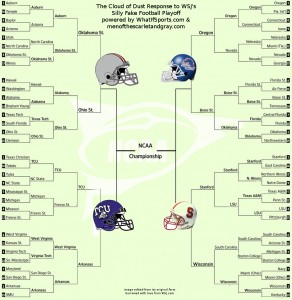Last week, the Wall Street Journal’s website ran an article that offered up a “conversion bracket” simulating a March Madness-style playoff for football, based on last year’s pre-bowl rankings and this year’s basketball tournament. Â The purpose of this exercise is to convince us that a football playoff would be bad because insane upsets would land Air Force in the Final Four.
There are number of flaws in this argument, the most glaring being the fact that football and basketball are remarkably different sports, especially in terms of pace and relative ease of scoring.  What it takes to pull off an upset in basketball is not at all the same as what it takes to pull off an upset in football.  Also keep in mind that this year’s basketball tournament is an anomaly of epic proportions.  Never before has a Final Four not contained at least one #1 or #2 seed.  Never.  Using the results of this tournament as a basis for what a football playoff would bring is disingenuous at best.
With that in mind, I turned to the infinitely awesome simulation site WhatIfSports.com to get a more realistic outcome of the Journal’s flight of fancy. Â Check out the results below. Â I’ll post the Final Four results in the comments, but feel free to speculate about what you think would happen.


Final Four results:
TCU 26, Ohio State 17 (Sorry, President Gee)
Boise State 43, Stanford 40
Boise State 27, TCU 14
That just about says it all, doesn’t it?
People who want an NCAA Tournament like playoff system forget that there won’t be 64 (65, 68 whatever) teams in the final field. It will be 16 at most and more likely 12. The reduced field immediately eliminates “upsets” that are only upsets because of the seeding.
Besides, like you point out, the game is so vastly different that true upsets (say a terrible Purdue team beating a pretty good Ohio State team) are few and far between.
That being said, it still would/will be fun if it ever happens.
There would absolutely be insane upsets occasionally in CFB playoffs – but most if not all would be limited to the first round only.
The biggest difference between BB and CFB playoffs would be that the CFB playoffs would favor teams that had more depth – the dropoff in talent between a schools’ #1, #2, and even #3 stringers would have to be minimal.
What CFB playoff proponents fail to understand is that the cinderella teams would would have NO CHANCE in a playoff. The playoffs would be dominated by the “few big schools†even more than the bowl games are now. They may be able to match up their best line with another team’s best line, but in the thick of a playoff bracket they would need to rely on their #2 & #3 lines. And that’s a big problem for mid-major teams, where the talent dropoff is super significant.
I’ve ranted about it before, but the bowl system is the only way “cinderella†teams have a shot to finish near the top of the polls. If NCAA goes playoff, then mid-major cinderella teams can say goodbye to whatever chances they have of winning national championships. All the $$ would be hoarded by the Pac 10, Big 10, Big 12, and SEC (which happens now, but not to the extent it would under a playoff).
The reasoning is this: consider Boise St against OK in January of 2007. I know Boise St. ended up with the suprise victory on the last statue of liberty play, but there’s no way a team with the mid-major’s definitive lack of depth could put back-to-back games together like that, as would be required of them in a playoff system. It took four weeks of hard practice and perfecting trick plays just to play well enough to take Oklahoma into overtime! And Oklahoma was not among the nation’s elite that year.
Had we been in a playoff, Boise St. would have faced an even better team just a few days later. Imagine the shock that would have gone through the Boise locker room that year, if their ecstasy over beating Oklahoma, for whom they had prepared for an entire month, was interrupted by news that just four days later they would have to take on USC to get to the next round.
CFB playoffs would kill the national championship hopes of 95% of the CFB world that couldn’t match the depth of the traditional powers.
@sM – A football playoff doesn’t have to (and wouldn’t) be set up like the basketball tournament (that is, no one would be playing two games 4 days apart). While I used the WSJ’s 64-team field for this piece, I think most CFB fans agree that 16 is the upper limit for a reasonable playoff.
I would propose a 16-team playoff integrated with the bowl season as such (using 2011 dates):
Sat. Dec. 3 – Conference Championships
Sat. Dec. 10 – Round 1
Sat. Dec. 17 – Round 2
Mon. Dec. 26 – Final Four
Mon. Jan. 9 – Championship
As the playoff progresses, time between games increases, including 2 weeks between F4 games and title game, all without extending the season even a day. This allows time to play the other bowls without being completely overshadowed by playoff games. It also opens up the possibility of including playoff losers in later bowl games to increase interest in those games.
I’m also curious as to what percentage of the CFB world you feel has a realistic championship hope under the BCS…
CoD – Even allowing for more time in the later rounds doesn’t necessarily make upsets more likely – as the favored opponents will also have the same amount of time. My point is that, while a cinderella CFB team can beat a ‘traditional power’ on any given Saturday, doing it for consecutive Saturdays in a row against the nation’s elite is very unlikely when they suffer from a comparable lack of talent at the lower roster positions.
>>I’m also curious as to what percentage of the CFB world you feel has a realistic championship hope under the BCS…<< In a playoff system, I think the traditional powers from the current BCS conferences will have a stronger hold on the championship than they currently do in the BCS system, where outsiders can still perform well enough to earn poll votes that give them a shot E.g., TCU last year, Boise the past few, etc.
sM – The problem I’m having here is that you seem to be equating making a BCS bowl to participating in a playoff. These things are not equal. Making it into a playoff field gives a team at least a small chance of winning a championship (even if that chance is realistically negligible). Only one BCS bowl offers that chance to only two teams.
A playoff that included TCU last year, or Boise State, Utah, Auburn, etc. in previous years is automatically more fair than the BCS.
Playoff opponents often declare these teams “unworthy” of that chance. If they are unworthy, if there is “no chance” of their winning it all, then what is the harm of giving them their shot? What would be lost that we get with the BCS?
CoD – in your reasoning, you are basically saying that the current BCS system is a two-team playoff. If that’s the only criteria for consideration, then of course a 16-team playoff is more fair than a 2-team.
I’m not really challenging that, or offering an opinion on that obvious aspect. All I was saying is that — REALISTICALLY — that is, considering the realistic, practical consequences and not the paper probabilities, a playoff system will benefit the traditional power schools more than it would the mid-majors, because (in my argument) the total talent on the roster of a given traditional power is spread broader across the backup lines. In the hypothetical CFB tourney world, that would be a paramount advantage.
sM – I acknowledged that the mid-majors realistically have a smaller chance than the power schools of winning a playoff. However, they have yet to even make it into the BCS title game, despite several of them going undefeated.
The other aspect you’re ignoring here is that no one is arguing that mid-majors deserve a system that makes it likely that one of them will win a title. What they do deserve is a system that gives them a chance (however small) to do so, without playing some unrealistically “tough” schedule that would be impossible to actually set up.
As far as the financial benefit, it is not difficult to design a plan that pays schools (or conferences) for each step in the playoff (i.e. an appearance payout + some % of playoff pot per win). Considering that EVERYONE (including BCS supporters) agrees that a playoff would bring in more money, there is no way that this does not result in more cash for the mid-majors than they get now (especially if all conference champs are guaranteed a spot).